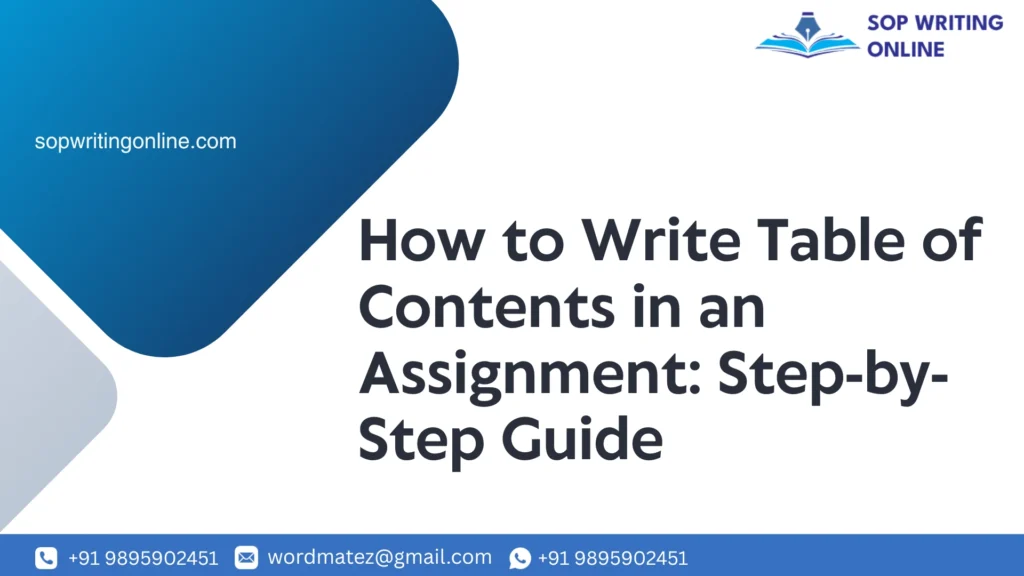How to Write Table of Contents in an Assignment: Step-by-Step Guide
When it comes to submitting a professional and well-organized assignment, one of the most essential yet often overlooked elements is the Table of Contents. If you’ve ever wondered how to write a table of contents in an assignment you’re in the right place. In this blog, we’ll break down the process, explain its importance, and show you exactly how to include a clear, accurate table of contents that enhances the overall quality of your academic work.

What Is a Table of Contents in an Assignment?
A table of contents in an assignment is a structured list of the main sections and subsections of your document, along with the page numbers where each section begins. It acts like a map for your readers, helping them quickly locate the parts they are most interested in. Whether you’re writing a report, essay, dissertation, or any academic paper, including a table of contents ensures better readability and presentation. In simple terms, the table of contents outlines the framework of your assignment. It usually includes major components like the introduction, methodology, body paragraphs, conclusion, references, and appendices.
Why Is the Table of Contents Important in an Assignment?
You might ask, “Is a table of contents really necessary?” The answer is yes—and here’s why:
- Improves Navigation: It lets the reader jump to specific sections without scrolling through the entire document.
- Enhances Presentation: A neat table of contents gives your work a polished, professional appearance.
- Shows Organization: It reflects your ability to plan and structure content logically.
- Saves Time: For professors or reviewers, a well-laid-out TOC makes reviewing your work quicker and easier.
Understanding what is table of contents in an assignment also helps you recognize its value as more than just a formal requirement.
How to Write Table of Contents in an Assignment
Writing a table of contents can be simple if you follow a few practical steps. Here’s how to get started:
1. Structure Your Assignment First
Before creating your table of contents, ensure your assignment has a clear structure with proper headings and subheadings. A well-organized paper will typically include:
- Title Page
- Abstract (if required)
- Introduction
- Literature Review
- Methodology
- Results/Findings
- Discussion
- Conclusion
- References/Bibliography
- Appendices
Each of these should be treated as a main section and formatted consistently throughout the document.
2. Use Consistent Heading Styles
To keep things organized, use a uniform style for all your headings:
- Main sections: Bold and in larger font (e.g., 14 pt)
- Subsections: Italic or slightly smaller font (e.g., 12 pt)
- Indentations: Use indentations for subheadings to show hierarchy
Using consistent formatting will make the TOC easier to generate, especially if you’re using a word processor like Microsoft Word.
3. Create the Table of Contents
There are two main ways to make a table of contents in an assignment:
Manual Method
For shorter assignments, you can manually create your TOC:
Table of Contents
- Introduction ………………………………….. 1
- Literature Review ………………………………. 3
- Methodology …………………………………… 5
3.1 Data Collection ……………………………. 6
3.2 Data Analysis ……………………………… 7
- Results ……………………………………….. 8
- Discussion ……………………………………. 10
- Conclusion ……………………………………. 12
- References ……………………………………. 14
- Appendices ……………………………………. 15
This format is clean and easy to read. Just make sure the page numbers are accurate.
Automatic Method (Using Word)
If you’re using Microsoft Word, you can generate the table of contents automatically:
- Apply “Heading 1,” “Heading 2,” etc. to each section title.
- Click where you want to insert the TOC (usually after the title page).
- Go to References > Table of Contents.
- Choose one of the built-in automatic formats.
Word will automatically list your headings with correct page numbers—and you can update it anytime you make changes.
4. Keep It Clean and Simple
Avoid overloading your TOC with unnecessary detail. Stick to:
- Main headings and important subheadings
- Clear titles that match the section names in your assignment
- Proper alignment and formatting
Your table of contents in assignment should be easy to scan and visually appealing.
5. Update Your TOC as Needed
One common mistake students make is forgetting to update their table of contents after editing their assignment. If you’ve changed section titles or added new content, be sure to:
- Manually adjust the TOC if you typed it out
- Click “Update Field” in Word to automatically refresh it
This step is crucial to avoid mismatched page numbers or missing entries.
How to Make Table of Contents in Assignment More Effective
To ensure your TOC adds real value to your assignment:
- Keep headings brief but descriptive
- Avoid abbreviations unless necessary
- Include only what’s necessary—don’t list every small paragraph
- Use dots or leader lines for visual clarity
A good table of contents isn’t just functional—it also makes a great first impression.
Final Thoughts
Whether you’re learning how to write a table of contents in an assignment for the first time or refining your technique, the steps in this guide will help you create a professional, easy-to-read TOC.

Anto Francis
Anto Francis is an academic writer with about a decade of experience behind him. Before becoming a full-time writer with us, he worked as an English Language Instructor in the Republic of Maldives. During the tenure he had helped thousands of students globally with a wide array of documents including SOP, LOR, personal statement, motivation letter and admission essays.
Share This Article
SOPWRITINGONLINE.COM is a one-stop-shop for all types of academic writing services for students seeking higher education. Besides SOP, we write LORs, Personal Statements, Scholarship Essays, Personal Essays, Motivation Letter, Student Resumes and a lot more.
